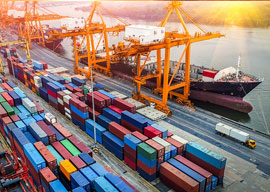What are the objectives and development does Pakistan’s trade policy and strategy look to achieve? For the last forty years, many developing economies and countries have captured the coat-tails of the global trade boom and jumped up the growth ladder by following an export-led growth strategy.
This strategy has frequently not been incorporated into a broader “ industrial policy” which has yet to accelerate industrialization while engineering a fabrication transformation of the economy; initially stepping from agriculture to industry, and later labor. From intensive low value-added exports to capital-intensive production involving innovation and technological sophistication.
With hardly any exceptions, the most successful arising economies of today have pursued an export-led trail for growth. While this growth strategy includes a myriad of policy interventions, each successful exporting nation follows a series of policies tailored to its specific needs & requirements. The general elements are as follows:
❖ Administration of export incentives
❖ Subsidized credit
❖ A depreciate exchange rate
❖ Selective liberalization of imports
While India may be quoted by some as an example of an economy that developed without a clear export-led strategy, the unprecedented growth in its manufactured exports over the past two decades has been a significant driver of growth. For example, while China’s exports have increased more than six-fold since the year 2000, India’s exports have grown more than five-fold, placing it second in the list of top-performing exporting countries during this period. Other top-performers have been Turkey, Vietnam, Bangladesh, and Cambodia.
Comparatively, Pakistan’s exports have grown 2.7 times during this period, making it one of the low achievers on this score.
It’s obvious, Pakistan has not done well in this regard. It is difficult to understand a clear long-term strategy that Pakistan has adopted with respect to export promotion over the past three decades, except in the Ayub-era push towards rapid industrialization, where a number of incentives were provided to industry and the export sector.
If anything, seeable and absurd- patterns appear when Pakistan’s trade administration and performance in recent times is critically examined: the policymakers of the country have a definite import bias rather than a distinct export bias.
The most conspicuous illustration of anti export policy bias and the almost unwanted emphasis on imports dates from the Musharraf Shaukat Aziz period. The nominal exchange rate was kept firm for several years, resulting in a real recognition of the rupee at a time when almost all successful exporting countries were actively using the frail currency as a policy tool to boost their exports.
Additionally, the State Bank of Pakistan unlatched the pecuniary tap and began downpouring the economy with cheap loans. A large portion of this credit was used to finance import-based consumption and subsequently, hundreds of billions of consumer loans were written off from banks’ balance sheets as myriad SBP- engineered credit bubbles burst.
In addition, import tariffs were drastically reduced. Pakistani negotiators signed on to lower ‘binding’ tariffs under the WTO than other developing countries. And above all, Pakistan went ahead and signed a Free Trade Agreement with China in the year 2006-only the third country to do so.
As a result of these erroneous policies, Pakistan’s imports increased, far exceeding exports, setting the stage for the biggest crisis of payments in the country’s history. To put this in perspective, as of 2008, the country’s imports exceeded US$40 billion, with exports funding less than 50% of the import payments.
More disastrously, the country’s manufacturing sector was hit by the opening up of all kinds of imports. At a time when the share of manufacturing in GDP increased in many countries of Asia, the share of Pakistan’s manufacturing sector in GDP decreased, as did its share in employment and new investment. During this period, many industries either closed down or came under pressure, including the manufacture of footwear, ceramics, and tyres. Massively low invoices and uncontrolled smuggling have compounded the industry’s problems.
While Pakistan has gone down the path of full-scale opening up of imports into the economy, successful exporting nations have adopted a more cautious liberalization of imports, restricting free imports into the export sector through bonded warehouses and export processing zones.
Some enthusiasts of “free trade” trust that the economy needs efficiency-boosting “constructive destruction”, and opening up to import is an upright way to achieve this. Despite the appeal of the free trade argument, no country exercises this approach. Therefore, the United States protects its auto, steel, and financial services industry- and deliberately subsidizes the agricultural and defense sectors. Japan protects its steel, agriculture, etc. whereas South Korea guarded shipbuilding for years, while the European Union has granted thousands of billions in subsidies for its “incompetent” agriculture.
Furthermore, to reduce the level of security of domestic agriculture and industry at a time of serious provocations such as the internal security circumstances and the energy predicament of the past seven years, and expect these sectors to enhance their efficiency under such circumstances and in some cases in opposition to subsidized competition are a prescription for disaster.
CONCLUSION
Pakistan needs to update its current import-export strategy and should learn from the policy experience and current exercise of big & successful economies, including India, and proceed towards greater liberalization in a phased and systematic manner.
For any query related to import-export trade data, you can connect with us at info@eximtradedata.com.or Visit site: https://www.eximtradedata.com






No comments:
Post a Comment